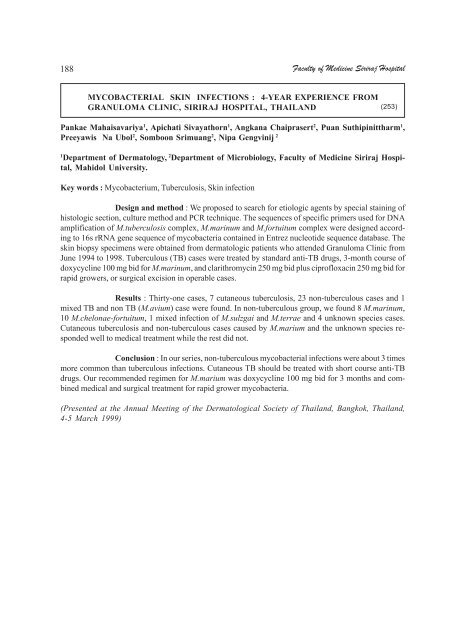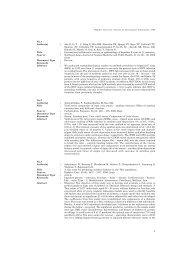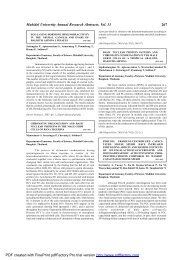THE OSTIA VENAE HEPATICAE AND THE RETHROHEPATIC ...
THE OSTIA VENAE HEPATICAE AND THE RETHROHEPATIC ...
THE OSTIA VENAE HEPATICAE AND THE RETHROHEPATIC ...
You also want an ePaper? Increase the reach of your titles
YUMPU automatically turns print PDFs into web optimized ePapers that Google loves.
188<br />
MYCOBACTERIAL SKIN INFECTIONS : 4-YEAR EXPERIENCE FROM<br />
GRANULOMA CLINIC, SIRIRAJ HOSPITAL, THAIL<strong>AND</strong><br />
(253)<br />
Pankae Mahaisavariya 1 , Apichati Sivayathorn 1 , Angkana Chaiprasert 2 , Puan Suthipinittharm 1 ,<br />
Preeyawis Na Ubol 2 , Somboon Srimuang 2 , Nipa Gengvinij 2<br />
1 2 Department of Dermatology, Department of Microbiology, Faculty of Medicine Siriraj Hospital,<br />
Mahidol University.<br />
Key words : Mycobacterium, Tuberculosis, Skin infection<br />
Faculty of Medicine Siriraj Hospital<br />
Design and method : We proposed to search for etiologic agents by special staining of<br />
histologic section, culture method and PCR technique. The sequences of specific primers used for DNA<br />
amplification of M.tuberculosis complex, M.marinum and M.fortuitum complex were designed according<br />
to 16s rRNA gene sequence of mycobacteria contained in Entrez nucleotide sequence database. The<br />
skin biopsy specimens were obtained from dermatologic patients who attended Granuloma Clinic from<br />
June 1994 to 1998. Tuberculous (TB) cases were treated by standard anti-TB drugs, 3-month course of<br />
doxycycline 100 mg bid for M.marinum, and clarithromycin 250 mg bid plus ciprofloxacin 250 mg bid for<br />
rapid growers, or surgical excision in operable cases.<br />
Results : Thirty-one cases, 7 cutaneous tuberculosis, 23 non-tuberculous cases and 1<br />
mixed TB and non TB (M.avium) case were found. In non-tuberculous group, we found 8 M.marinum,<br />
10 M.chelonae-fortuitum, 1 mixed infection of M.sulzgai and M.terrae and 4 unknown species cases.<br />
Cutaneous tuberculosis and non-tuberculous cases caused by M.marium and the unknown species responded<br />
well to medical treatment while the rest did not.<br />
Conclusion : In our series, non-tuberculous mycobacterial infections were about 3 times<br />
more common than tuberculous infections. Cutaneous TB should be treated with short course anti-TB<br />
drugs. Our recommended regimen for M.marium was doxycycline 100 mg bid for 3 months and combined<br />
medical and surgical treatment for rapid grower mycobacteria.<br />
(Presented at the Annual Meeting of the Dermatological Society of Thailand, Bangkok, Thailand,<br />
4-5 March 1999)

















